I hope you all have had an excellent Fall Break! Below is the documentary news program we were watching Friday before we left for break. Please take the time to watch the rest of a program that puts the human into human geography.
Monthly Archives: September 2018
BIG Update! Migration Related!
Many of you guys theorized based on our GIS analysis that Spain would be a good alternative to entering the EU from Italy (provided Gibraltar is not the entry point of course). Well guess what? You were right! Spain as of today is now leading the EU in migrant entry. Check out the news story that just broke this morning right here!
Ah the power of spatial analysis.
Migration in the News

Below are two very interesting current stories that were run by NPR News in the past 24 hours. I would encourage you to listen to both of them.
The first is dealing with Guatemalan immigration into the United States. You can listen to the story by clicking HERE.
The second is dealing with new United States policy on refugees. You can listen to the story by clicking HERE.
HONORS GEOGRAPHY- GIS MAP ASSIGNMENT REGARDING ENVIRONMENT AND AGRICULTURE
Migration, on the move GIS Map
Click HERE for access to a GIS map on European migration.
Prill AP Human Mapping Monday Reminders
Don’t forget folks, tomorrow is a big day:
–Gravity Model Lab is due when you walk in
–Mapping Monday makes its big return, and it will be over either whatever your class has left from the western hemisphere, Western Europe, or Eastern Europe
–Make sure you are well prepared on the final assigned section from chapter 3 of your text as we wrap up Unit II tomorrow.
Hang in there… this time next week, we’re on Fall Break!
AP Human Geography Unit II Review Guide
Click HERE for a review of major points contained in Unit II that will help you prepare for your testing next week.
Prill’s 1st and 4th period class updates- GRAVITY MODEL
Hi folks, hopefully things are coming along with your lab regarding the Gravity Model, and that you see this as a rather useful predictor for governments, marketing agencies, retailers, etc. In any case, just a few things…
–I heard that some lab assignments were missing pages 108 and 109. If that is the case for you, and you have not yet received the missing pages, click HERE for them.
–Please be sure that you are working diligently tomorrow and typing out WELL-REASONED, CRITICALLY THOUGHT OUT responses to part 4 of your lab. Remember that this is double spaced in a word document. Nothing that appears to be submitted in a shared google doc will be accepted. In fact, any evidence of plagiarism of any kind will result in a zero for the lab.
–When you turn in your lab work on Monday, you will turn in a spreadsheet, a scatter plot diagram, a residual map, and your typed responses, with your name on everything submitted.
–Finally, don’t forget Monday is Mapping Monday and you have a final reading to be doing this weekend.
See you next week…
Important Announcement for Prill’s 1st and 4th Period Classes
Hi guys, so it’s official, I will not be on campus tomorrow or Friday. My son was diagnosed with Hand Foot and Mouth Disease today (which just sounds like something straight out of stage 2 of the epidemiological transition if you ask me), which is highly contagious and so he has to be quarantined at home for the rest of the week. I will be the one staying home with him for the rest of the week.
That said, your next lab, relating to the Gravity Model, will still take place over tomorrow and Friday. NOTE: You should be using the state of GEORGIA in this lab as your case study destination. If you have questions, Mrs. Darling will try to drop in, and of course, you can always email me or post questions to the comments section on this post. My best advice once again though is to read directions carefully. You will be working for the first time with spreadsheets in this lab, but they’re pre-programmed, so as long as you’re following the directions as they are written you won’t have problems as the formulas already programmed in the spreadsheets are perfect (in other words, your computer will not be “messing up” so if something is wrong check what you’re plugging in).
Regarding today’s class, I can’t emphasize enough the need to know these major migration streams that we’ve been looking at extremely well. Based on popular request, some of the major ones we’ve been discussing are on the map below.
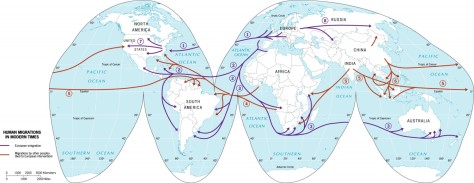
Additionally, recall some of the major regional flows that we have looked at (or didn’t get to in 4th period, but here they are below just the same). The map below depicts a regional flow that was largely sparked by Chinese social and political problems in the late 1800s and early 1900s. Many remain and today they make up substantial portions of the population (14% in Thailand, 32% in Malaysia, 76% in Singapore).
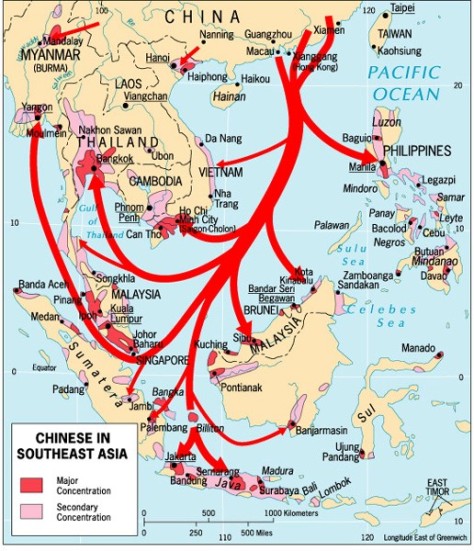
The Latin America to North America flow below is particularly important.
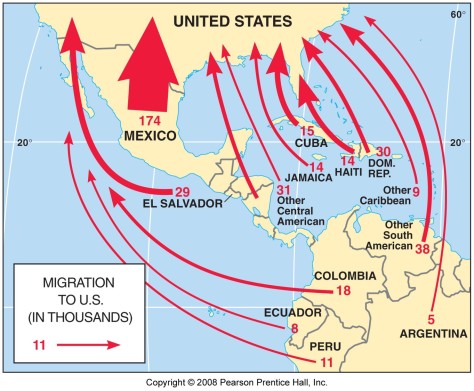
The recent numbers are a bit different than what you have on this older map from your textbook, and the numbers are probably much higher, but undocumented entry doesn’t end up in these statistics. Nevertheless, in the past 50 years there have been 13 million migrants from Latin America to the United States (compare that to 2 million in the 200 years prior to the 1970s). Again, like in Asia the big push really began as the realities of stage 2 of the demographic transition really began to kick in.
Additionally, know your big migration streams within the United States:
–more than half of Americans immigrate to California, Florida, New York, and Texas.
–historically movement in the United States has been a westward one, and more recently has trended towards the south as well (with growing economic opportunities being the pull into the south).
–An additional trend has been movement into (urban) metropolitan areas. In 1800 only 5% of Americans lived in urban areas, in 2015 that number had risen to 81%.
–During the 1980s and 1990s, the move to the “Sunbelt” was significant with 5 million people a year moving into the South from the Northeast, Midwest, and West, compared with 2 million moving out. The movement has, however, slowed considerably in the 21st century, as can be comparatively seen on the two maps below.
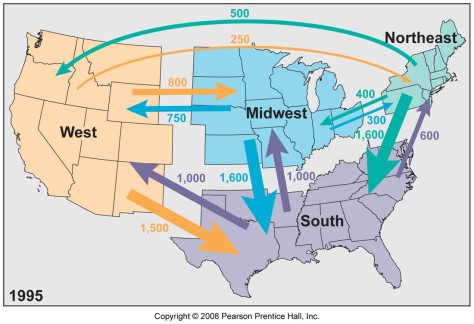
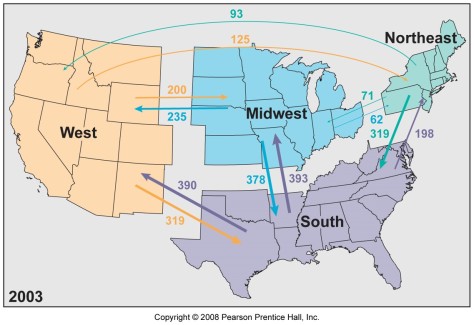
–An additional trend that has been seen in the US is movement from urban to suburban areas (nearly 2x Americans move urban to suburban than the reverse), which is common throughout the developed world whereas in the developing world the trend remains rural to urban. This move, however, is not an economic one but more tied to the “suburban lifestyle,” which would include the desire for a detached house, a yard, free parking, higher rated schools, etc. This trend has decreased though since 2010 with a new movement happening in the United States back to inner-cities.
–A final trend being seen the the United States is urban to rural movement, known as counterurbanization (see this trend on the map below). Partially this is because of suburbs continuing to expand into what was formally farmland, but there is more genuine urban to rural movement also, especially in the Rocky Mountains region of the US. This is possible in the 21st century as there are no longer truly isolated places in this country with the ability to shop online and work remotely via the Internet.
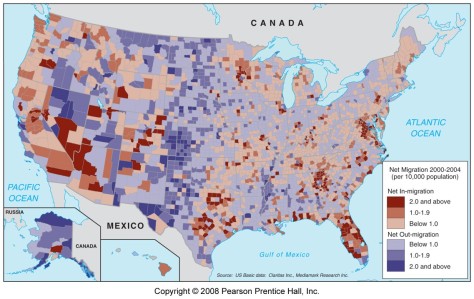
Finally, the United States is not the only country where internal migration is quite common.
–In Russia, starting in the 1800s people migrated east from the Moscow and St. Petersburg heartland. Eastward expansion is a constant trend in Russian history as both Russian and Soviet leaders tried to occupy the eastern frontiers, so they moved industry east, built the Trans-Siberian Railroad, and established Vladivostok as a naval base. More recently, however, the movement in Russia is back west toward the “European sector.”
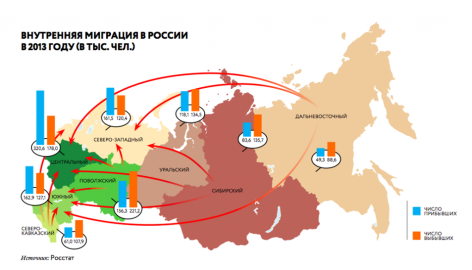
–In China, the largest rural to urban in history has been seen between 1970 to the present. Mostly the movement is from the western interior towards the east coast where there are more job opportunities to take advantage of.
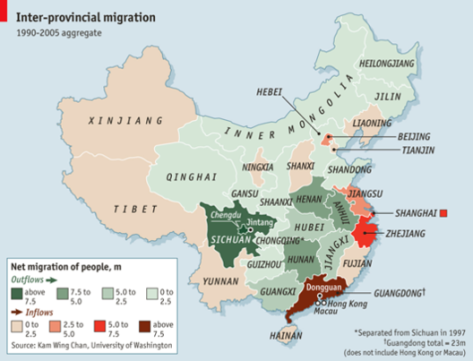
Phew! That just about covers it finally! This focus on internal migration is the perfect bridge to learning the GRAVITY MODEL. Enjoy the next two days getting comfortable with it. Your lab is due on Monday when you come in, and we will briefly discuss the highlights. See you Monday for Mapping Monday in which your options will be whatever is still hanging in there from the Western Hemisphere and now anywhere in Western or Eastern Europe added to the mix.
HONORS World Geography ONLY- Map Quiz Western Europe
You can click on the link below to pull up a map of Europe for Monday’s map quiz.
Remember it is helpful to use the Human Geography in Action online resource package to help you quiz yourself on the maps that you will be responsible for. You can access that by clicking here.
Although you will see a map for all of Europe below, you are only responsible for the following countries for this map:
Andorra
Austria
Belgium
Denmark
Finland
France
Germany
Greece
Iceland
Ireland
Italy
Luxembourg
The Netherlands
Norway
Portugal
Spain
Sweden
Switzerland
United Kingdom
